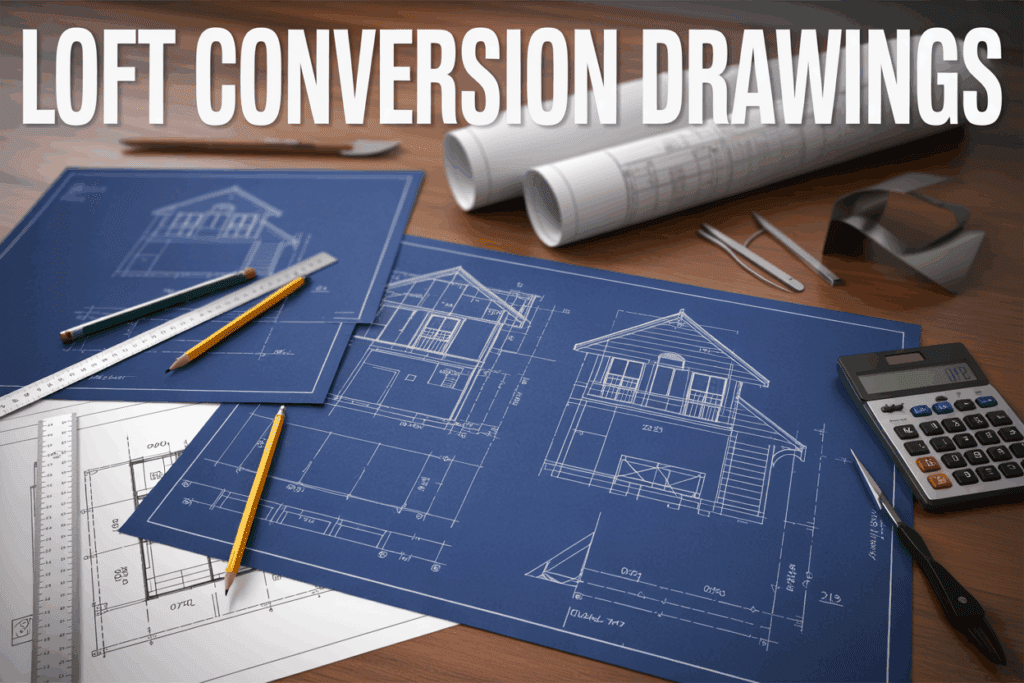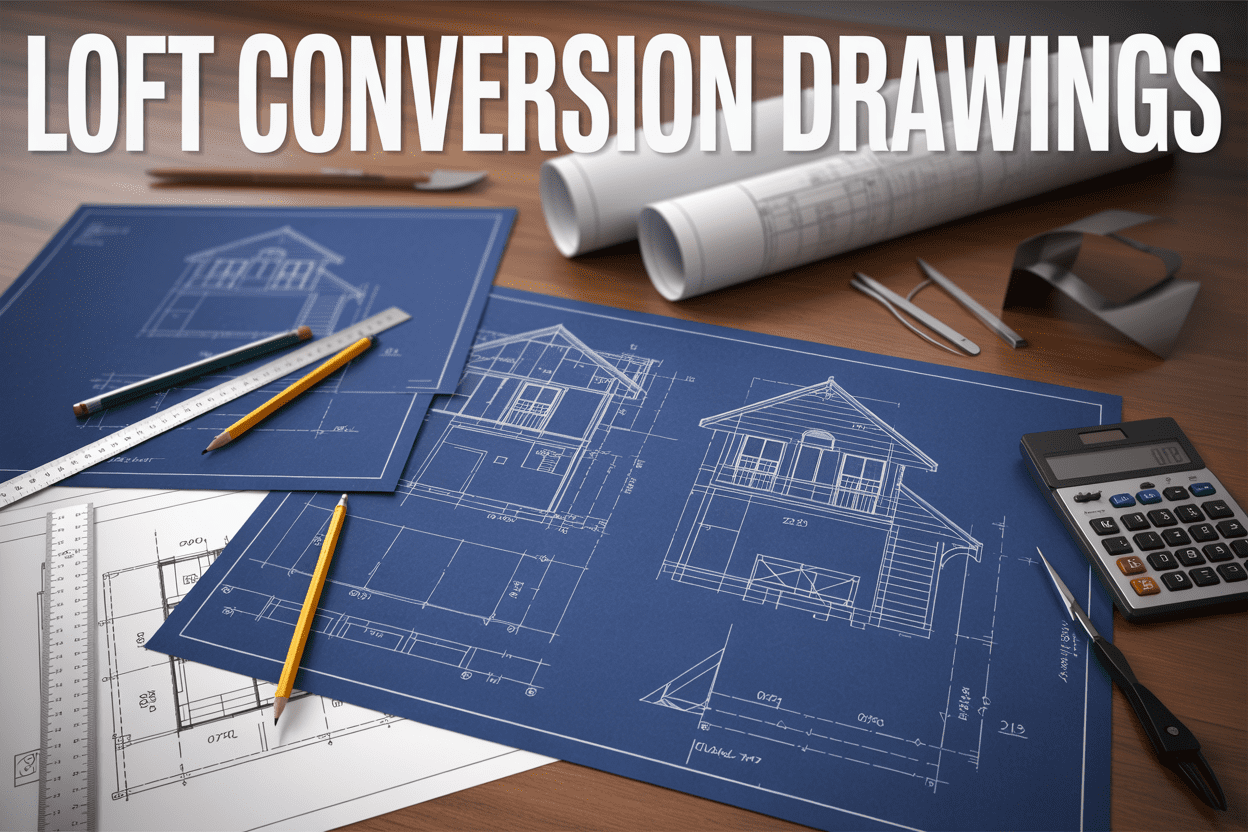Embarking on a loft conversion in 2025? The single most critical step is the creation of precise, compliant loft conversion drawings. These aren’t just pretty pictures; they are the legal and technical backbone of your project, dictating everything from planning permission to the final build.
This comprehensive guide is designed for homeowners, builders, and developers in the UK, especially those navigating the complexities of loft conversion drawings London‘s unique planning environment. We’ll demystify the various types of drawings needed, explain the critical role of structural engineering, detail planning permission requirements, and even break down loft conversion drawings cost.
Understanding these plans is essential for transforming your attic into a beautiful, safe, and legal living space. Let’s explore how expert loft conversion drawings turn your vision into a reality.
Types of Loft Conversion Drawings and Plans
Every loft conversion requires a specific set of architectural plans. The type of conversion dictates the complexity and detail of these loft conversion drawings.
Detailed Loft Conversion Drawings London Examples by Type
Whether you’re planning a simple Velux conversion or a complex L-shaped dormer, each requires specific loft conversion detail drawings.
- Velux Loft Conversion Drawings for Bungalows: These are often the simplest, focusing on integrating roof windows into the existing roofline. The loft conversion drawings will show window placement, internal staircase access, and basic floor layouts within the sloped space.
- Rear Dormer Extension Plans and Elevations: A dormer loft conversion creates vertical walls and a flat roof, significantly increasing headroom. Loft conversion drawings for these include detailed elevations showing the new dormer from the outside, floor plans of the expanded internal space, and sections indicating structural changes.
- Hip to Gable Conversion Technical Drawings: For properties with a hipped roof, a hip to gable conversion extends the sloping side roof vertically to form a gable end. The loft conversion drawings will clearly illustrate this structural alteration and how it impacts the roof profile.
- L-shaped Dormer Conversion Blueprints: These complex loft conversion drawings combine a main dormer with a second one over an existing rear extension (like a kitchen outrigger), creating a substantial increase in usable floor area. The blueprints show how these two dormers connect to form an ‘L’ shape.
- Pitched Roof Dormer Architectural Drawings: Unlike flat roof dormers, these feature a small pitched roof on the dormer itself, often chosen for aesthetic reasons or to match existing architectural styles. The loft conversion detail drawings highlight the specific roof angles and construction.
- Crown Dormer and Flat Roof Dormer Plans: These are variations of dormers, each with unique aesthetic and structural considerations. The loft conversion drawings will specify the precise construction and integration with the main roof.
Essential Drawing Components for Successful Loft Conversions
Regardless of the type, every set of loft conversion drawings must include these critical components:
- Floor Plans: Showing room layouts, dimensions, furniture placement, and fire escape routes.
- Elevation Drawings: Displaying external changes, material specifications, and how the new loft impacts the property’s appearance from each side.
- Section Drawings: Revealing internal structure modifications, ceiling heights, insulation details, and key dimensions through cross-sections of the building.
- Site Plans: Indicating property boundaries, surrounding context, and often the location of drains and other utilities.
Planning Permission & Structural Drawings for Loft Conversion
Securing the necessary approvals is paramount. Your loft conversion drawings are the primary documents for both planning and structural assessment.
Planning Permission Requirements for Loft Conversion Drawings London (Govt.UK )
London’s planning rules can be intricate. Your loft conversion drawings London must clearly demonstrate compliance.
- Permitted Development Drawings: Many loft conversions fall under Permitted Development (PD), meaning full planning permission isn’t required. However, detailed loft conversion drawings are still essential to obtain a Lawful Development Certificate (LDC), which officially confirms your project is lawful.
- Full Planning Permission Application Drawings: If your project exceeds PD limits (e.g., volume exceeding 40m³ for terraced, 50m³ for detached, or building in a Conservation Area), full planning permission is needed. The submitted loft conversion drawings must be comprehensive, demonstrating respect for neighbours’ light and privacy. For more detail, consult the .
- Building Regulation Compliance Drawings: All loft conversions, regardless of planning status, require Building Regulations approval. These highly detailed loft conversion drawings specify structural integrity, fire safety, insulation, ventilation, and access. Consult the page for comprehensive details.
Structural Drawings for Loft Conversion: The Engineering Backbone
The structural drawings for loft conversion are arguably the most critical plans, ensuring the safety and longevity of your new space.
- Structural Engineering Drawings and Calculations: Prepared by a qualified structural engineer, these loft conversion detail drawings show how the new floor joists, steel beams, and roof structure will be supported. They detail the precise dimensions, materials, and connections needed to ensure the loft can safely bear its new load and that the existing structure is not compromised.
- Professional Expertise: A professional loft conversion specialist London will coordinate seamless input from structural engineers and potentially building surveyors to ensure your loft conversion drawings are technically sound.
Cost Considerations for Loft Conversion Drawings
Understanding loft conversion drawings cost is crucial for accurate project budgeting. These fees are an investment that prevents far greater expenses down the line.
Loft Conversion Drawings Cost: Breaking Down the Fees (UK)
The overall loft conversion drawings cost varies depending on complexity, location, and the level of service required.
- Professional Drawing Service Fees: Architectural design services for a full set of loft conversion drawings (including initial concepts, planning, and Building Regulations) typically range from £1,500 to £5,000+ for a standard London conversion. This often represents 5-10% of the total build cost.
- Planning Application Drawing Costs: If full planning permission is required, the application fee in England is £206 (2024 figures). This is separate from the architect’s fees for preparing the loft conversion drawings themselves.
- Building Regulation Drawing Expenses: The Building Control application fee is also separate and depends on the project’s value. Your loft conversion specialist London will advise on this.
- Value Engineering: Proper loft conversion drawing enable value engineering, where architects optimize design and materials during the planning stage to reduce overall build costs without compromising quality or compliance. (Internal Link: Get a detailed breakdown for your project with our calculator.)
Real-World Loft Conversion Plan Examples and Variations
Seeing loft conversion plans examples can help you visualize the potential of your space.
- Before and After Conversion Plan Comparisons: High-quality architectural services often provide detailed comparisons showing existing layouts versus proposed new plans.
- Drawing Variations for Different Property Types: The loft conversion drawing for a terraced house will differ significantly from those for a detached bungalow due to varied structural requirements and planning constraints.
- Regional Planning Authority Drawing Requirements: Be aware that specific councils in London might have unique local requirements for loft conversion drawing, making local expertise invaluable. (Internal Link: Explore a gallery of to inspire your project.)

Precise, compliant loft conversion drawing are the cornerstone of a successful project. They transform your ideas into a buildable reality, secure necessary approvals, and protect your investment. Understanding the types of drawings, planning requirements, structural drawings for loft conversion, and associated costs ensures a smooth journey from concept to completion.
By engaging an expert loft conversion specialist London, you ensure your loft conversion detail drawings are meticulously prepared, fully compliant, and optimized for both design excellence and structural integrity.

